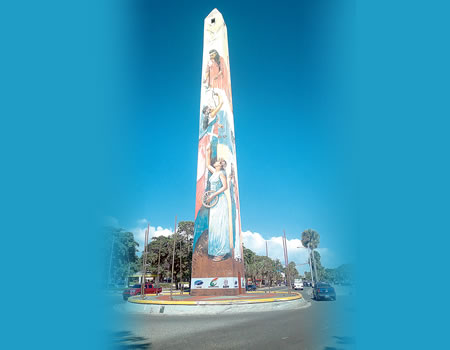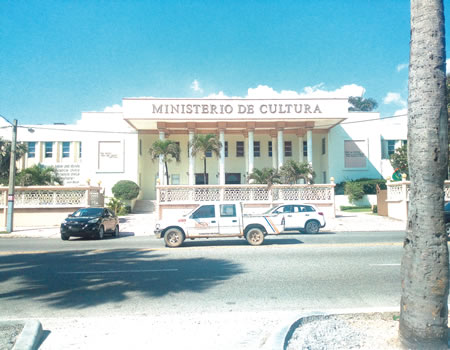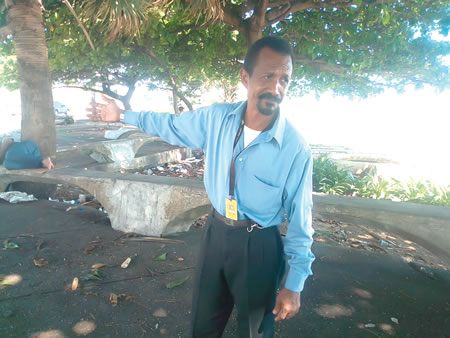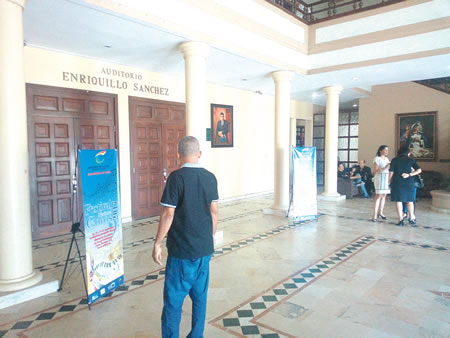
Though disconnected from their roots by reason of the slave trade and the attendant effects that peopled their realities in the new world, many Africans re-negotiated and re-enacted the rich aspects of their culture and heritage. The depth of these aspects became noticeable in Santo Domingo, the capital of the Dominican Republic, a country in Latin America when African, native and European cultures crossed. Little wonder, Santo Domingo, till date, is referred to as the city of encounters. KEHINDE OYETIMI, who was on a three-week visit to the city, writes on the rich surviving aspects of African heritage and culture. These cultural remnants as preserved by Dominicans of African descent, otherwise referred to as Afro-Dominicans, still thrive and such rich aspects of the African heritage are visibly expressed in dance, music, language, economy, cuisine and religious beliefs.
51-year-old Carlos Santos and his son, Rafael, had come to the Central Olympic Stadium, Felix Sanchez, to attend the first session of a state-wide crusade organised by the Christian community of the Dominican Republic, in partnership with Prophet T.B. Joshua, a Nigerian evangelist. Santos happily stated that “I was particularly glad when I was told that an African was coming. Don’t be carried away by my skin colour, my great grandparents were from Kenya. I am everything African even though we are Dominicans. For many years, we have been doing everything humanly possible to preserve our African identity. I came out to attend this programme because other Afro-Dominicans, like me, will indeed be happy to be here. We hold festivals to ensure that we continue to express our African culture.”
Smiling beside Santos was 40-year-old Pena Cruz, also an Afro-Dominican. Cruz stated that unlike Santos whose ancestry was traced to Kenya, his could be traced to Ghana. “My forebears were from Ghana. I have visited Ghana many times. I ensure that I go there with my family once in a year. Many of our great-grandparents were brought in here from Africa as a result of slavery. But through the many centuries, we have not stopped connecting with our African background. We have found means to always express our African essence. We visit other neighbouring countries like Brazil, Argentina and Mexico where we know that African culture is celebrated,” he said.

As captured by Santos and Cruz, Latin America and the Caribbean, two major regions of the world were historically the initial areas of the Americas where immigrants of African descent populated immensely. The trajectory of the African slave experience moved from West Africa to Brazil. From Brazil, slavery moved from the Caribbean to South America.
Though brought to their new settlements in servitude, these Africans were not daunted by the harsh realities of their lives. Their descendants, like Santos and Cruz, despite forming minority ethnic groups in many Latin American nations, have repeatedly added the rich depths of their African culture, as passed down by their great-grandparents, to their respective countries.
Music and dance
While it is true that Afro-Dominicans form a minority group in the country, the Dominican Republic has recorded a growing African presence in several aspects of the nation’s social life with music being one of them.
Some of the rich aspects of the nation’s rhythms which clearly resonate the African tradition can be found, as Santos says, in “musica de palos. This means the music of sticks. We also have the baile de palos. It means the dance of sticks. We have Música de Congos (Music of Congos); Cantos de Hacha (Songs of axe), los congos, la jaiba (the crab).” As observed, other instruments borrowed from the African music tradition include the gallumba and balsie. Santos also identified other musical instruments whose origins can be traced to Africa — the conoita (as seen in the bachata, referred to as the bongos), the tambora (this is one of the key instruments used in the meregue music. This is the Dominican national dance) and also the Palo mayor.
Religion and African syncretism
An Afro-Dominican culture enthusiast, Castor Galeano, spoke glowingly about the prevalence of the belief in the world of the dead, the living and the unborn. Galeano, while praising the richness of the Yoruba culture which has spread its reach from West Africa to Latin America, stated thus: “I have traced my ancestry to West Africa. That is where I came from and I am very proud about that. In many parts of West Africa, you find the Yoruba people there. But even beyond that, you will find out that the belief system of West Africans was transported to many parts of Latin America. There is the belief in the world of the living, the unborn and the dead. For Africans, the ancestors are alive. Despite the fact that we have embraced various religions that were found here, we still find ways to express our belief in the world of the ancestors.”

It was observed that although a vast majority of Dominicans subscribed to Catholic and Pentecostal Christianity, Afro-Dominicans exhibit layers of religious syncretism. African descents display their beliefs through funeral rites and what Galeano refers to as “Dominican vudu”. “Dominican vudu is voodoo as practised in many parts of West Africa. As Afro-Dominicans, we also believe that there are different gods,” he said.
Speaking further, he stated that “when holding funeral rites for the dead, we ensure that we do the needful. We respect the dead because we believe that they are not dead. They watch over us. When my parents died, I consoled myself with the fact that they are not dead because they still watch over me. I gave them befitting burials. They are in the world of the ancestors where they are praying for us.”
Economy, farming, cuisine
For many Afro-Dominicans, one of the lasting legacies of the slave encounter of their forebears was the communal presence on the farms. Today, across some plantations, the landowner employs farm hands to help in cultivation and harvesting of farm produce. Across many parts of Santo Domingo, the nation’s capital, are fruits for sale, though cheap. Euginia Gomez, and Afro-Dominican stated that “we also cultivate farms here. One of the things that were left for us by early settlers of African descent was the communal efforts during farming. We work together and while doing so, we sing and dance. We bring dance instruments. You can see us use the call-and-response technique while farming or clearing large portions of land. This is part of us. We are very proud of this and after the entire work, a festival is held where we relax and enjoy one another’s presence.”
Across many parts of Africa, mutual aid establishments thrive. This practice is common among the Yoruba people and other ethnic tribes. The revolving credit system ensures the financial security of each of the contributors. Otherwise referred to as esusu, this practice is also common in the country.

According to Gomez, “we ensure that the mutual aid system thrives here. Women from low strata of the society usually participate in this and it is very helpful. The revolving loan ensures that we are not stranded during moments of economic desperation. Even though it might be little, it is our financial stay, especially when you consider the huge interest that conventional banks put on their loans.”
Festivals celebrating African heritage
The months of February and June witness carnivals and festivals. It was gathered that African heritage is celebrated in June. “As Afro-Dominicans, we look forward to months that celebrate African culture and heritage. We hold beauty pageants and parades that honour our African culture. In October, we hold the Puerto Plata festival which takes into consideration the celebration of musical genres with African origin. These genres include merengue, salsa, folk and jazz. We are very happy because these represent the depth of the African spirit, culture and essence,” Galeano stated.
When this reporter visited the nation’s Ministero De Cultura (Ministry of Culture), the nation’s traditional cojuelo mask could be seen. According to Galeano, “just as masks are very central to African culture, so we also treasure them here. They hold very sacred meanings. The cojuelo mask is usually displayed during one of our major festivals here. We borrowed the mask symbol from our African heritage.”
Despite their fractured history and the various shortcomings that make up their presence in Latin America, Dominicans of African descent have continued to contribute in no small measure in ensuring that African culture is reflected in all facets of life in the Dominican Republic.



